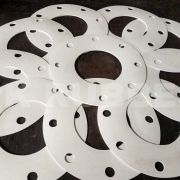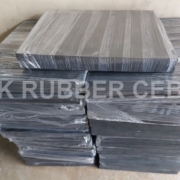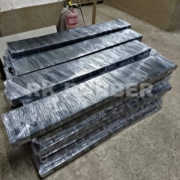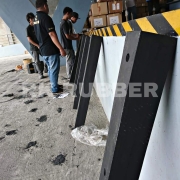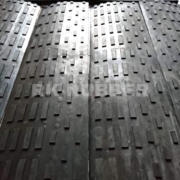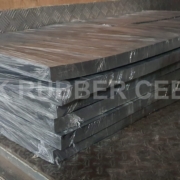RK Rubber stands out as a leading rubber bumper supplier in Cebu City, specializing in high-quality products designed to meet the rigorous demands of various industries. Their rubber bumpers are crafted from durable synthetic materials, ensuring longevity and optimal impact resistance. RK Rubber offers extensive customization options, allowing clients to select dimensions, colors, and materials tailored to specific applications. They adhere to stringent quality control protocols, ensuring reliability and performance. Additionally, user feedback plays a crucial role in their continuous improvement efforts. Those interested in maximizing bumper performance and longevity will find essential insights just ahead.
Key Points
- Look for local suppliers in Cebu City specializing in custom rubber bumpers for various industrial applications and requirements.
- Check for manufacturers that offer extensive customization options, including dimensions, colors, and materials to suit specific needs.
- Ensure the supplier uses high-quality synthetic rubber and employs rigorous quality control protocols for durability and reliability.
- Inquire about the supplier’s commitment to sustainability and eco-friendly practices in their bumper production processes.
- Evaluate customer reviews and testimonials to assess the supplier’s reputation and service quality in Cebu City.
Importance of Rubber Bumpers
Rubber bumpers play a crucial role in safeguarding both equipment and infrastructure across various industries in Cebu City. Their impact resistance is vital in mitigating damage during collisions, thus preserving the integrity of machinery and structures. By effectively absorbing vibrations, rubber bumpers minimize wear and tear, extending the lifespan of critical assets and reducing maintenance costs.
The cost savings associated with rubber bumpers stem from their ability to prevent costly repairs and replacements, making them a financially sound investment for businesses. Additionally, the safety benefits cannot be understated; by cushioning impacts, they create a safer working environment, reducing the risk of accidents and injuries.
Moreover, the emphasis on environmental sustainability is increasingly relevant in Cebu City. Many rubber bumpers are manufactured from eco-friendly materials, promoting a greener approach to industrial operations. Their durability ensures a long service life, further reducing waste. As industries strive to balance productivity with sustainability, the adoption of rubber bumpers emerges as a practical solution that aligns with both economic and ecological goals. In summary, rubber bumpers are indispensable for enhancing safety, ensuring cost efficiency, and supporting sustainable practices in various sectors.
Key Features of RK Rubber Cebu
RK Rubber Cebu is distinguished by its extensive customization options, allowing clients to tailor rubber bumpers to specific dimensions, colors, and materials that meet their operational needs. The company utilizes durable and reliable materials to ensure that their products withstand various environmental challenges, providing long-lasting performance. Additionally, the versatile applications of RK Rubber’s bumpers cater to a wide range of industries, from automotive to industrial machinery, enhancing functionality and safety across multiple sectors in Cebu City.
Customization Options Available
Customization options offered by RK Rubber Cebu are designed to meet the diverse needs of clients across various industries. With a focus on design flexibility, RK Rubber allows customers to tailor rubber bumpers to their specific applications, ensuring optimal performance and protection. Clients can select from a wide range of color choices, enhancing visibility and aesthetic appeal, which is crucial for branding purposes.
In addition to color, size variations are available, accommodating various industrial requirements—from small components for delicate applications to large bumpers for heavy machinery. This adaptability ensures that clients receive products precisely suited to their operational needs.
Moreover, RK Rubber Cebu provides multiple material options, allowing customers to choose based on environmental conditions and impact resistance requirements. This customization not only enhances functionality but also offers branding opportunities, as clients can incorporate logos or specific designs into the bumpers, promoting their brand identity.
Durable and Reliable Materials
Utilizing high-quality materials is essential for ensuring the durability and reliability of rubber bumpers manufactured by RK Rubber Cebu. The rigorous material selection process begins with sourcing premium synthetic rubber that meets specific performance criteria. Each batch undergoes durability testing to ensure optimal impact performance, making our bumpers ideal for various applications in demanding environments.
The manufacturing processes employed at RK Rubber Cebu include advanced vulcanization techniques, which enhance the mechanical properties of rubber, ensuring resilience against wear and tear. This process not only increases the longevity of the bumpers but also minimizes the environmental impact, as high-quality materials are less prone to degradation, reducing waste over time.
Moreover, our commitment to sustainability is reflected in the careful selection of raw materials, which are designed to withstand harsh conditions while maintaining eco-friendly characteristics. The result is a product that not only meets industry standards but exceeds expectations in durability and reliability. RK Rubber Cebu’s rubber bumpers are engineered to perform consistently, providing protection in industrial, automotive, and residential applications, thereby safeguarding investments and enhancing operational efficiency.
Versatile Applications Offered
The exceptional durability and reliability of rubber bumpers manufactured by RK Rubber Cebu enable a wide range of versatile applications across various sectors. These bumpers are designed for optimal performance, ensuring impact resistance and vibration dampening, which are critical in protecting valuable assets. Their environmentally sustainable design aligns with modern industrial practices, promoting responsible use of materials.
Key applications include:
- Industrial Machinery: Protects equipment from damage, ensuring longevity and reducing maintenance costs.
- Automotive Solutions: Enhances safety during loading and unloading, absorbing shocks and preventing vehicle damage.
- Furniture Protection: Minimizes wear and tear on surfaces, maintaining aesthetic integrity.
- Transportation and Docking Areas: Safeguards structures from impact, thereby ensuring operational efficiency.
The installation simplicity of RK Rubber Cebu bumpers ensures minimal downtime, while their cost-saving attributes foster long-term financial benefits. With a commitment to quality and performance, RK Rubber Cebu provides tailored solutions that cater to the unique needs of various industries, ultimately enhancing safety and efficiency in operations.
Types of Rubber Bumpers
Rubber bumpers are categorized into various types, each tailored for specific applications, including general purpose, automotive, and industrial uses. In Cebu City, RK Rubber Cebu provides customizable bumper options that cater to diverse industry needs, enhancing their functionality and effectiveness. Understanding these types and their respective applications is crucial for selecting the right bumper to ensure optimal performance and protection.
General Purpose Bumpers
General purpose bumpers serve as essential protective elements across various applications, from industrial machinery to everyday furniture. These versatile components are designed to absorb impacts, ensuring the longevity of equipment and reducing the risk of damage. Proper installation techniques enhance their performance, making them indispensable in various settings.
Key benefits of general purpose bumpers include:
- Impact Resistance: High resilience materials absorb shocks effectively, safeguarding surfaces during collisions.
- Environmental Sustainability: Many options are crafted from eco-friendly materials, aligning with market trends towards sustainability.
- Cost Analysis: Investing in rubber bumpers can significantly reduce repair costs associated with damage, offering a long-term financial advantage.
- Versatility: Available in various sizes and shapes, these bumpers can be customized to fit specific needs, catering to both industrial and residential applications.
Incorporating general purpose bumpers not only enhances safety but also contributes to a more efficient operation, as their durability minimizes maintenance requirements. As the demand for reliable protective solutions grows, understanding the features and advantages of these bumpers is crucial for informed decision-making in Cebu City and beyond.
Automotive Bumpers Overview
Automotive bumpers play a vital role in vehicle safety and functionality, specifically engineered to absorb impact during collisions and protect critical components. These bumpers must meet stringent automotive safety standards, focusing on impact resistance and durability. Various bumper materials, such as thermoplastics and rubber composites, are used to enhance performance and ensure longevity.
| Bumper Type |
Key Features |
Typical Applications |
| Front Bumpers |
High impact resistance, aerodynamic |
Passenger vehicles, SUVs |
| Rear Bumpers |
Protection during low-speed impacts |
Trucks, commercial vehicles |
| Specialized Bumpers |
Designed for specific uses |
Off-road vehicles, sports cars |
Installation techniques have evolved, utilizing advanced fastening systems for optimal performance. Design innovations, including energy-absorbing structures and lightweight materials, contribute to improved fuel efficiency and reduced repair costs. In Cebu City, RK Rubber Cebu specializes in providing tailored automotive bumpers that meet local needs while maintaining compliance with international standards. By investing in high-quality bumpers, vehicle owners can enhance safety and performance, ultimately protecting their investments in the long run.
Industrial Bumper Applications
While various types of bumpers serve essential functions across different sectors, industrial rubber bumpers are particularly crucial for protecting machinery and infrastructure within manufacturing and warehousing environments. These bumpers offer a combination of impact resistance and noise reduction, vital for maintaining a safe workplace. Their design facilitates effective vibration absorption, ensuring equipment longevity and operational efficiency.
The applications of industrial rubber bumpers can be summarized as follows:
- Machinery Protection: Safeguards equipment from damage during operation, enhancing productivity.
- Material Handling: Cushions goods during transportation, preventing breakage and loss.
- Vehicle Safety: Protects industrial vehicles during loading and unloading, adhering to safety protocols.
- Docking Areas: Absorbs impacts at loading docks, minimizing infrastructure wear and tear.
Installation techniques are straightforward, allowing for quick deployment without extensive downtime. Properly installed rubber bumpers not only comply with safety protocols but also contribute to a quieter, more efficient work environment. By investing in high-quality industrial rubber bumpers, businesses in Cebu City can bolster their operational efficacy while ensuring adherence to safety standards.
Customizable Bumper Options
Rubber bumpers are available in a diverse array of customizable options, tailored to meet the specific needs of various applications in Cebu City. Customers can benefit from extensive color selection, ensuring that bumpers can match the aesthetic requirements of their projects or enhance visibility in industrial settings. Size variations allow for precise fitting, accommodating the unique dimensions of machinery, vehicles, or furniture.
Shape customization is another critical aspect, enabling the creation of bumpers that fit specific contours or functional requirements, thereby maximizing protection and performance. Additionally, these bumpers offer branding opportunities, as logos or designs can be incorporated into their production, allowing businesses to promote their identity effectively.
Performance enhancements are also available through specialized materials and designs, optimizing bumpers for specific applications such as heavy machinery or sensitive equipment. This customization ensures that each bumper not only meets but exceeds expectations, providing reliable protection while extending the lifespan of assets. RK Rubber Cebu specializes in delivering these tailored solutions, ensuring that clients receive high-quality rubber bumpers that align with their operational needs and standards.
Customization Options Available
Customization options for rubber bumpers are extensive, allowing clients to tailor products to their specific needs and applications. At RK Rubber Cebu, we understand that each industry has unique requirements, and we offer a range of customization choices to enhance performance and aesthetic appeal.
- Color Selection: Clients can choose from a variety of colors, ensuring visibility and compliance with industry standards.
- Shape Variation: We provide diverse shape options, enabling the bumpers to fit perfectly in various applications, from automotive to industrial use.
- Material Choices: Different rubber formulations are available, including options for enhanced chemical resistance or temperature stability, catering to specific environmental conditions.
- Branding Options: Custom branding can be incorporated, allowing businesses to showcase their logos on bumpers, increasing brand recognition while providing functional benefits.
Additionally, size customization is available, ensuring that the bumpers meet precise spatial requirements for any project. By utilizing these customization options, clients can maximize the effectiveness of their rubber bumpers while aligning them with their operational goals and branding strategies.
Quality Control in Manufacturing
At RK Rubber Cebu, the commitment to delivering high-quality rubber bumpers extends beyond customization options to include rigorous quality control measures throughout the manufacturing process. Our quality assurance methods encompass stringent protocols that ensure every product meets the highest standards. We employ standardized impact testing procedures that assess the durability and performance of our bumpers under various conditions, simulating real-world applications.
Additionally, our production efficiency strategies focus on optimizing each step of the manufacturing process, from sourcing to final assembly. We adhere to strict supplier selection criteria to guarantee that all raw materials meet our specifications for quality and reliability. This includes meticulous evaluation of material sourcing practices to ensure that only the best synthetic rubber is utilized, allowing for enhanced performance and longevity of our bumpers.
Maintenance and Care Tips
Proper maintenance of rubber bumpers is essential to ensure their longevity and optimal performance in various applications. Regular upkeep not only enhances performance but also contributes to cost savings and minimizes environmental impact.
Here are four critical maintenance tips to consider:
- Regular Cleaning: Use mild soap and water to clean the bumpers, preventing dirt buildup that can affect performance.
- Proper Storage: Store bumpers in a cool, dry place away from direct sunlight to prevent deterioration and maintain elasticity.
- Installation Techniques: Ensure that bumpers are installed correctly using suitable adhesives and techniques. This not only enhances their lifespan but also optimizes shock absorption.
- User Feedback and Performance Testing**: Regularly seek user feedback** and conduct performance testing to identify any issues early on. This proactive approach ensures that bumpers perform effectively under varying conditions.
Implementing these maintenance tips can significantly extend the lifespan of your rubber bumpers, leading to fewer replacements and greater overall efficiency. By prioritizing care and attention, you can positively impact both performance and sustainability in your operations.
Frequently Asked Questions
What Industries Primarily Use Rubber Bumpers?
Rubber bumpers are primarily utilized in automotive applications, industrial machinery, construction equipment, furniture protection, and electronic devices. Their versatility allows for effective impact absorption, enhancing safety and durability across various sectors and applications.
How Can I Request a Custom Rubber Bumper Quote?
To request a custom rubber bumper quote, specify your custom specifications, desired material options, and design considerations. Additionally, indicate order quantities to facilitate accurate pricing strategies and ensure your needs are effectively addressed.
What Is the Typical Lead Time for Orders?
The typical lead time for orders varies based on production timelines and order processing efficiency. Shipping methods and bulk discounts may influence delivery schedules, while dedicated customer support ensures timely updates throughout the fulfillment process.
Are Rubber Bumpers Environmentally Friendly Options Available?
Yes, environmentally friendly rubber bumpers are available, utilizing eco-friendly materials and sustainable manufacturing practices. Biodegradable alternatives can significantly reduce environmental impact throughout their life cycle, promoting sustainability while maintaining durability and performance in various applications.
Can Rubber Bumpers Be Recycled After Use?
Rubber bumpers can be recycled through specialized recycling processes, minimizing environmental impact. Their material sustainability supports effective waste management, while rubber alternatives may also be utilized to enhance recyclability and reduce overall ecological footprints in various applications.
Conclusion
In conclusion, rubber bumpers serve a critical function in safeguarding assets across various sectors, significantly enhancing safety and durability. RK Rubber Cebu stands out as a premier supplier, offering a wide range of customizable options while adhering to rigorous quality control standards. The application of environmentally friendly materials further emphasizes the commitment to sustainable practices. Through innovative engineering and dedicated service, RK Rubber Cebu continues to meet the evolving needs of its diverse clientele in Cebu City and beyond.

